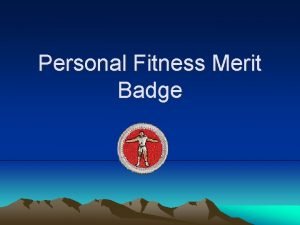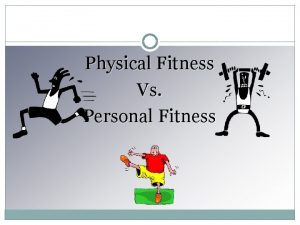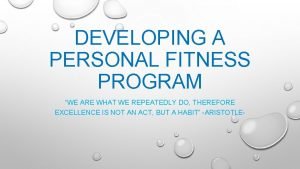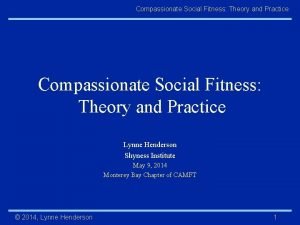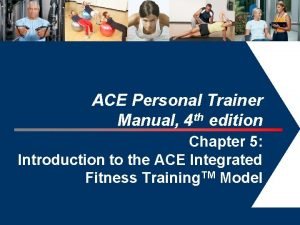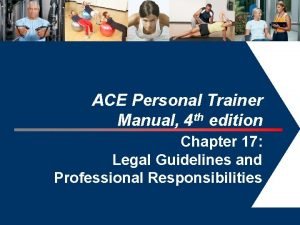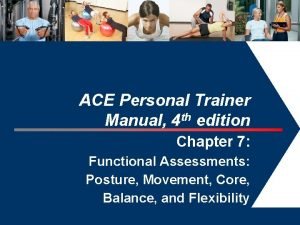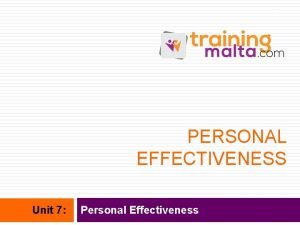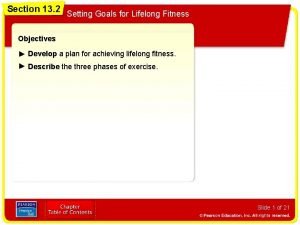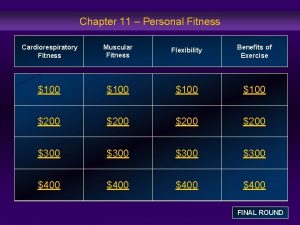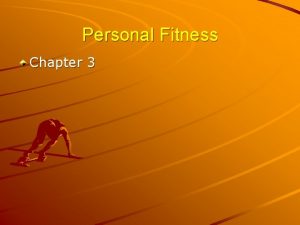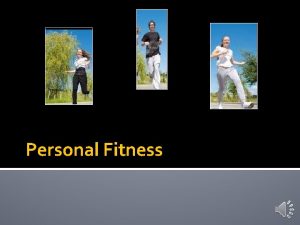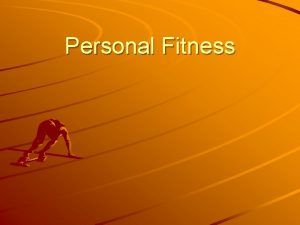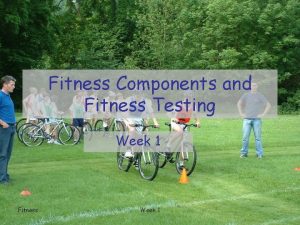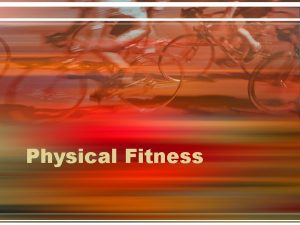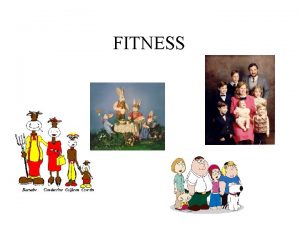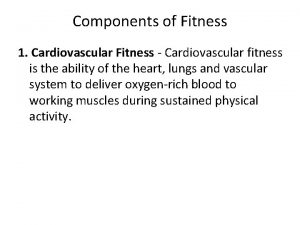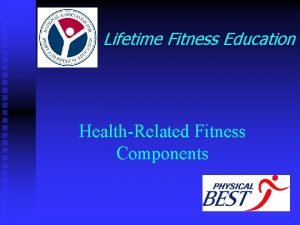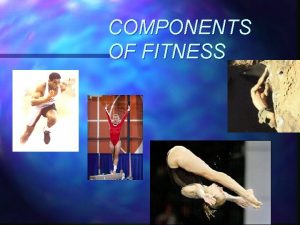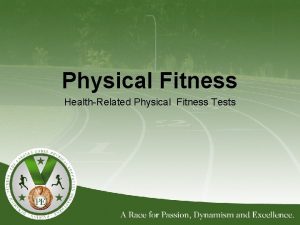Personal Fitness and Training Personal Fitness and Training




















- Slides: 20

Personal Fitness and Training

Personal Fitness and Training n Personal training and the design of exercise is about helping people adopt, enjoy, and maintain an active lifestyle n 3 -Stage Approach: § Stage 1: Individual Objectives § Stage 2: Assessment (Information Gathering) § Stage 3: Appropriate Exercises

STAGE 1: Objectives n Designing personalized exercise programs involves helping the individual choose exercise elements that suit their goals. n Goals provide a visual picture of a future outcome; goal setting is important and can lead to even more focused outcomes. n Objectives are action-oriented and indicate how well and under what conditions the outcome should be performed.

Stage 1: Information Gathering Health and Lifestyle Appraisal n Health status and lifestyle should be assessed during the early phase of counseling, BEFORE the fitness assessments to ensure there are no health risks. (injury, asthma, high blood pressure? ) n A health and lifestyle appraisal, may be a first step to behavioral change.

STAGE 2: Fitness Assessment n The second stage of designing an exercise program involves gathering more detailed information through the assessment of physical fitness.

Why and What to Assess? n Fitness assessments help to identify physical abilities and areas that need improvement. n Baseline measures are useful in setting goals and can be used to monitor progress and adjust exercise programs. n Some individuals will be looking simply to improve their general fitness while others may seek more performance-related or health-related fitness.

Performance-Related Fitness Necessary for higher levels of sport performance or optimal work performance n Examples include: - motor skills (stick handing, dribbling) - speed (20 m, 40 m, 100 m, 200 m) - agility (T drill, 20 m shuttle) - coordination (often sport specific) - cardiovascular endurance (VO 2 max) - muscular power (max vert, power lifting) – muscular strength (1 Rep Max (RM) - muscular endurance (max # of pushups) n

Health-Related Fitness Includes: - body composition (fat distribution) - muscular balance (assess for injury) - cardiovascular functions (sub-maximal exercise capacity) - metabolic components (blood work by doctors) n

Cardiovascular Assessment Cardiovascular endurance is one of the best indicators of personal fitness n Determined by the maximal amount of oxygen (VO 2 max) that the human body is able to utilize per minute of physical activity n Ex: Beep Test, Step Test, in Lab testing n

Body Composition Assessment The term body composition refers to fat mass and lean body mass (non-fat). n Test examples: - Hydrostatic weighting (most effective) - bioelectrical impedance - skin fold thickness - girth measurements n

Referenced Body Fat % Values Male Female Elite 5 -6% <15% Lean 10% 15% Standard 15% 23% 25%+ 32%+ Risk

Muscular Strength Assessment Muscular strength is the maximum tension or force a muscle can exert in a single contraction. (max vertical hump, powerlifting) n Determined by the maximal amount of resistance that an individual can lift in a single effort (1 RM, 5, RM, 10 RM). n A true 1 RM for the chest muscle, for example, during a bench press may be difficult to obtain because earlier trails will leave the client fatigued. n


Muscular Endurance Assessment n Muscular endurance is the ability of the muscle to perform repeated or sustained contractions over a period of time. n Assessed by the number of repetitions that an individual can perform against a sub-maximal resistance, or by the length of time a contraction can be sustained. (Max sit up, push ups to failure)

Flexibility and/or Muscle Tightness Assessment Flexibility refers to the ability of a joint to move freely through its full range or motion (ROM). n Gender and age have a major influence on joint flexibility. n Most athletes forsake working on their flexibility because of time constraints n

Stage 3: Guidelines for Developing an Exercise Program n n Actual fitness program should have appropriate exercises for selected goals determination of the personalized program depends greatly on the athlete’s level of fitness (baseline testing) athletic aspirations (short & long term goals) type of training (Specificity of F. I. T. T. Principles)

Designing Aerobic Exercise Programs n n n Aerobic training is safe and well suited for many different individuals and activities. Use of the F. I. T. T. Principle Proper warm-up required Circuit training is effective for the development of the cardiorespiratory & muscular system at the dame time Interval training is effective in working any energy system; achieves the greatest amount of work with the least fatigue

Interval Training Elite athletes require interval training and more sport-specific aerobic training to meet their goals. n A typical IT program involves: § determining the energy system § selecting the type of exercise § selecting work interval, number of repetitions and sets, work -relief ratio, and type of relief n

Designing Anaerobic Exercise Programs n n Most anaerobic programs require an aerobic base. Anaerobic training is used most frequently for recreational, intercollegiate, elite, and professional athletes whose sports involve the use of the two anaerobic energy systems. Use of the F. I. T. T. Principle Can be extremely taxing both physiologically and mentally on the body; important to avoid overtraining; cool-down period is very important following this type of fitness program

General Program Design - Safety Issues n Safety issues that are prominent during each exercise program segment: – – Preparation (Warm-Up) Segment – ROM movements to increase joint lubrication and body temperature Aerobic Segment – Monitor heart rate; Talk Test Resistance Segment – Warm-up; adequate relief between sets; follow weight-room safety rules Cool-Down Segment – Target muscles used in the workout; emphasis on static stretching
 Skills related
Skills related Chapter 4 nutrition and your personal fitness
Chapter 4 nutrition and your personal fitness Merit badge personal fitness
Merit badge personal fitness Fitness chap 1
Fitness chap 1 Personal fitness definition
Personal fitness definition Fitness program plan
Fitness program plan Compassion theory
Compassion theory Ift model
Ift model Principles of training individuality
Principles of training individuality El infinitivo, el gerundio y el participio son formas.
El infinitivo, el gerundio y el participio son formas. Adivinanzas del aseo personal
Adivinanzas del aseo personal Kraytiryang
Kraytiryang Daniela perolli
Daniela perolli Ace personal trainer insurance
Ace personal trainer insurance Plumb line posture
Plumb line posture Cyq level 3 certificate in personal training
Cyq level 3 certificate in personal training Personal effectiveness framework
Personal effectiveness framework Training is expensive without training it is more expensive
Training is expensive without training it is more expensive Metode of the job training
Metode of the job training Aggression replacement training facilitator training
Aggression replacement training facilitator training Chapter 13 exercise and lifelong fitness
Chapter 13 exercise and lifelong fitness


